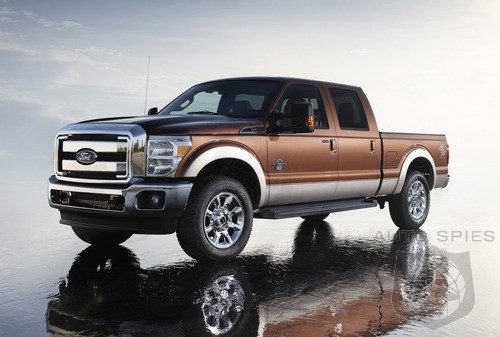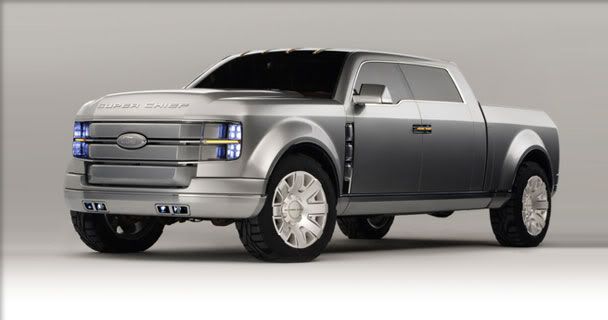The Super Chief (assigned train Nos. 17 & 18) was the first Diesel-powered, all-Pullman sleeping car train in America, and it eclipsed the Chief as Santa Fe's standard bearer. The extra-fare Super Chief-1 commenced its maiden run from Dearborn Station in Chicago on May 12, 1936. Just over a year later, in May, 1937 the much-improved Super Chief-2 traversed the 2,227.3 miles (3,584.5 km) from Los Angeles over recently upgraded tracks in 36 hours and 49 minutes, averaging 60 miles per hour (97 km/h) overall, and often reaching 100 miles per hour (160 km/h).

Ford F250 Super Chief Concept

The Super Chief also features
From that day forward the Super Chief set a new standard for luxury rail travel in America. With only one set of equipment, the train initially operated but once a week from both Chicago and Los Angeles. However, at the height of its popularity, and with added equipment, the trains of the Super Chief made daily departures from both ends of the line. Adding to the train's mystique were its gourmet meals and Hollywood clientele.

Ford Super Chief sips three
Direct competitors to the Super Chief during its lifetime were the City of Los Angeles, a streamlined passenger train jointly operated by the Chicago and North Western Railway and the Union Pacific Railroad, and (to a lesser extent) the Golden State, a streamlined passenger train jointly operated by the Rock Island and Southern Pacific railroads. The Santa Fe Super Chief was one of the last passenger trains in the United States to carry an all-Pullman consist; only the Pennsylvania Railroad's Broadway Limited and the Illinois Central's Panama Limited survived longer. The train maintained its legendary high level of service until the end of Santa Fe passenger operations on May 1, 1971.

Ford\x26#39;s official press release
When Amtrak took over operation of the nation's passenger service on May 1, 1971 it ended the 35-year run of the Super Chief on the Santa Fe, though Amtrak would continue to use the name along the same route for another three years. In 1974 the Santa Fe forced Amtrak to drop the train's name due to a perceived decline in service. Amtrak replaced the train over the same route with its Southwest Limited. Following the delivery of new Superliner equipment, the Santa Fe compromised with Amtrak and the train became known as the Southwest Chief in 1984.

2011 Ford Super Duty

Ford Super Chief Concept Front
The heart of Santa Fe's marketing advantage for the Super Chief lay in the geography of the route as well as its ownership. The Santa Fe had originally begun as the constructing of a rail line traversing the old Santa Fe and Spanish Trails, from the confluence of the Missouri and Kansas rivers (at Atchison and Topeka, KS) to the Pecos and Rio Grande rivers in New Mexico. This initial route was eventually extended to Los Angeles.

Ford F-250 Super chief 2011

Ford F-250, 2006 Concept Truck

Ford Super Chief
The convenience of traveling "Santa Fe All The Way", was superior to anything that the competing jointly operated railroads could provide on their routes to the west coast. A single traffic and operating department ruled all the divisions and districts of the Santa Fe route from Chicago to Los Angeles. Dining cars, the commissary supply chains, the on-board service crews and their management; all worked as a single unit (as they were working for a single company) from the moment a passenger boarded the train in Chicago, until they alighted in Los Angeles.

Tags: 2013 Ford F250 Super

Ford Super Chief sips three
The original Super Chief route ran from Chicago through Kansas City, Missouri; Newton, Kansas; Dodge City, Kansas; La Junta, Colorado; Raton, New Mexico; Las Vegas, New Mexico; Albuquerque, New Mexico; Gallup, New Mexico; Winslow, Arizona; Seligman, Arizona; Needles, California; Barstow, California; San Bernardino, California; and Pasadena, California, before terminating at Los Angeles. During the pre-war years the Super Chief did not allow passengers to board or disembark at any point between Kansas City and Barstow; all intermediate stops were operating stops only, to change crews and/or to service the train. During the war years the rules were relaxed to carry passengers to and from the intermediate points of Albuquerque and La Junta, but only when unsold space was available at train time. It was not until the postwar era that passengers could freely travel to intermediate station stops on the Super Chief.

2012 Ford Super Chief

Ford Super Chief F-250

2011 Ford Super Duty

Ford Super Chief - Rear

Ford F 250 Super Chief 1

Ford F250 Super Chief Concept

The Super Chief also features
From that day forward the Super Chief set a new standard for luxury rail travel in America. With only one set of equipment, the train initially operated but once a week from both Chicago and Los Angeles. However, at the height of its popularity, and with added equipment, the trains of the Super Chief made daily departures from both ends of the line. Adding to the train's mystique were its gourmet meals and Hollywood clientele.

Ford Super Chief sips three
Direct competitors to the Super Chief during its lifetime were the City of Los Angeles, a streamlined passenger train jointly operated by the Chicago and North Western Railway and the Union Pacific Railroad, and (to a lesser extent) the Golden State, a streamlined passenger train jointly operated by the Rock Island and Southern Pacific railroads. The Santa Fe Super Chief was one of the last passenger trains in the United States to carry an all-Pullman consist; only the Pennsylvania Railroad's Broadway Limited and the Illinois Central's Panama Limited survived longer. The train maintained its legendary high level of service until the end of Santa Fe passenger operations on May 1, 1971.

Ford\x26#39;s official press release
When Amtrak took over operation of the nation's passenger service on May 1, 1971 it ended the 35-year run of the Super Chief on the Santa Fe, though Amtrak would continue to use the name along the same route for another three years. In 1974 the Santa Fe forced Amtrak to drop the train's name due to a perceived decline in service. Amtrak replaced the train over the same route with its Southwest Limited. Following the delivery of new Superliner equipment, the Santa Fe compromised with Amtrak and the train became known as the Southwest Chief in 1984.
2011 Ford Super Duty

Ford Super Chief Concept Front
The heart of Santa Fe's marketing advantage for the Super Chief lay in the geography of the route as well as its ownership. The Santa Fe had originally begun as the constructing of a rail line traversing the old Santa Fe and Spanish Trails, from the confluence of the Missouri and Kansas rivers (at Atchison and Topeka, KS) to the Pecos and Rio Grande rivers in New Mexico. This initial route was eventually extended to Los Angeles.

Ford F-250 Super chief 2011

Ford F-250, 2006 Concept Truck

Ford Super Chief
The convenience of traveling "Santa Fe All The Way", was superior to anything that the competing jointly operated railroads could provide on their routes to the west coast. A single traffic and operating department ruled all the divisions and districts of the Santa Fe route from Chicago to Los Angeles. Dining cars, the commissary supply chains, the on-board service crews and their management; all worked as a single unit (as they were working for a single company) from the moment a passenger boarded the train in Chicago, until they alighted in Los Angeles.
Tags: 2013 Ford F250 Super

Ford Super Chief sips three
The original Super Chief route ran from Chicago through Kansas City, Missouri; Newton, Kansas; Dodge City, Kansas; La Junta, Colorado; Raton, New Mexico; Las Vegas, New Mexico; Albuquerque, New Mexico; Gallup, New Mexico; Winslow, Arizona; Seligman, Arizona; Needles, California; Barstow, California; San Bernardino, California; and Pasadena, California, before terminating at Los Angeles. During the pre-war years the Super Chief did not allow passengers to board or disembark at any point between Kansas City and Barstow; all intermediate stops were operating stops only, to change crews and/or to service the train. During the war years the rules were relaxed to carry passengers to and from the intermediate points of Albuquerque and La Junta, but only when unsold space was available at train time. It was not until the postwar era that passengers could freely travel to intermediate station stops on the Super Chief.

2012 Ford Super Chief

Ford Super Chief F-250

2011 Ford Super Duty

Ford Super Chief - Rear

Ford F 250 Super Chief 1
No comments:
Post a Comment